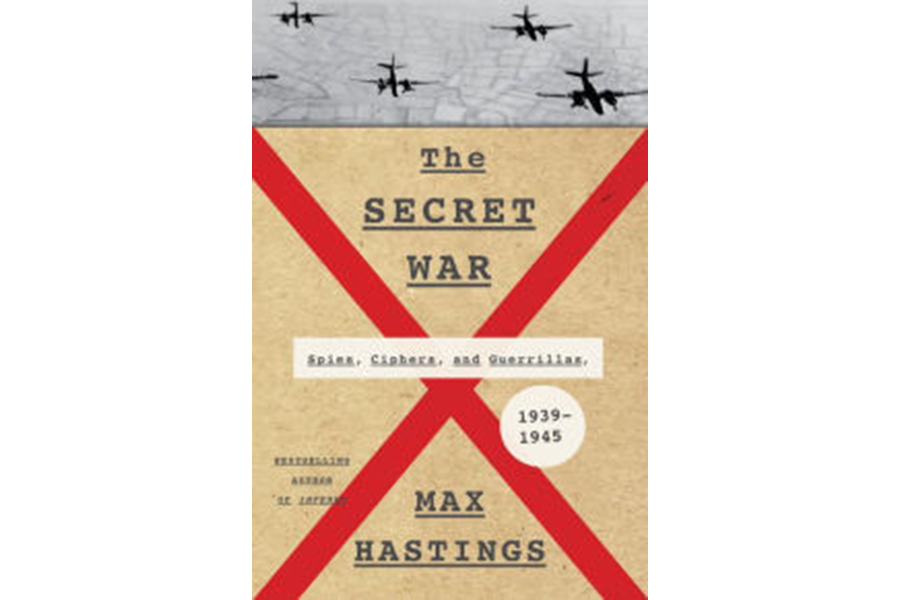'The Secret War' tells the remarkable story of World War II espionage
Loading...
Books about World War II could easily fill a large library. But those focused on espionage and the intelligence aspects of the conflict would comprise only a small part and most of these – like Ben Macintyre’s books “Double Cross” and “Operation Mincemeat” – only consider individual operations. Readers wanting a clear, comprehensive assessment of how the full range of espionage and codebreaking operations affected the war have had few choices.
That vacuum has now been filled. The highly respected British military historian Max Hastings has written an authoritative and engaging book that will stand as the definitive single volume analysis of “The Secret War” for years to come. His central theme is that all the major participants engaged in extensive espionage activities to inform and empower their armed forces. Some of these were well thought out while others were badly planned. A few were wildly successful but many were failures. But, ultimately, these covert operations assumed an unprecedented importance in the conflict.
Fundamental to Hastings’s analysis is the distinction between signals intelligence, information obtained from interception radio traffic ( known as “signet”), and human intelligence, insights gained from spies, informers, agents, prisoners of war, and even newspapers (known as “humint”). “Humint” is as old as warfare but “signet” became increasingly important in World War II when primitive technology was available to help decode intercepted messages.
Standing above all of these was the successful effort to crack the German “Enigma” code, an undertaking spearheaded by a remarkable team at Bletchley Park in England. Ironically, thanks to the Cold War and the desire to hide the Allied code breaking operations, the existence of this effort was not widely known until the 1974 publication of “The Ultra Secret” by F.W. Winterbotham. Even then the world took only modest note – Hastings himself reveals that as a young scholar he declined to review Winterbotham’s book because he “had never heard of Bletchley Park.”
Yet today, he calls Bletchley “one of the most remarkable institutions the world has ever known, and one of the greatest achievements in Britain’s history, towering over any narrative of the nation’s part in the conflict” and says it is “a source of national shame” that Alan Turing, the most storied member of the team that cracked the Enigma code committed suicide in 1954 after his homosexuality was revealed.
His central question is quite simply, “Did the secret war affect the outcome of the conflict?” The answer is still widely debated. Many historians assume that the Allies’ successes in these areas shortened the war by a year or two but others, like Yale historian Paul Kennedy, argue that intelligence and espionage efforts were characterized by “a preponderance of failures.” Hastings sides with those who believe that the intelligence efforts contributed to the final victory, even if many of the resources devoted to those activities were used inefficiently and ineffectively.
While assessing the impact of intelligence efforts, Hastings underscores that knowing the enemy’s plans was not enough to secure victory because combat operations determine the outcome of armed conflict. In some cases, Allied soldiers were unable to capitalize on the battlefield even when they knew where their opponents would strike. But in other cases, intelligence provided a decisive edge. When American naval officer Joseph Rochefort broke a Japanese code and accurately predicted that Japan would attack Midway Island, he gave the US Navy enough information to thwart the attack and turn the tide in the Pacific. Hastings calls this “the most influential signal intelligence achievement” of the war.
Part of the pleasure of the book is meeting a cast of characters (the only appropriate word) who are largely unknown today. British agent Ronald Seth, for example, was parachuted into the Baltics to foment resistance. He was quickly captured and appears to have become a German agent providing false information to London. But his stories were so fantastic that neither side was sure who he was working for.
Or Richard Sorge, a German who became a committed Communist and joined the Soviet Army’s intelligence organization. He worked at the German embassy in Tokyo where he quickly gained the respect of the Japanese government. So he simultaneously (and successfully) spied on the Germans for the USSR and on the Japanese for the Germans. Unsurprisingly, his career did not end happily.
Or Baron Hiroshi Oshima, Japan’s well-connected Ambassador to Germany. Because America had broken the Japanese diplomatic code, the Allies read some 2,000 of his dispatches, giving them their most important insights into the thinking of Hitler’s inner circle. Indeed, since the Soviets told Washington and London relatively little about the fighting on the Eastern Front, Oshima’s dispatches proved exceptionally valuable.
The Soviet Union’s cynicism and duplicity is breathtaking. Stalin – always very focused on the postwar world – was perfectly willing to deceive and spy on his allies and did so with great success. But the most amazing secret story may have been the so-called “Mars” deception. To camouflage the Russian Army’s counterattack at Stalingrad, Stalin planned a large-scale military operation north of Moscow and tipped off the German army before the operation began. Suitably warned, the Germans crushed the Russian attack. The deception killed 70,000 Soviet soldiers but the Stalingrad operation was protected.
This is a marvelous book – smart, carefully and exhaustively researched and highly informative. Even those exceptionally knowledgeable about World War II will find it extremely valuable. It is compelling and fascinating reading.
And, as Hastings notes, interest in the challenges posed by intelligence, eavesdropping, and code-breaking operations has never been greater. Electronic surveillance of communications is now a primary weapon used by Western nations (especially the US and Great Britain) to combat terrorism. So the lessons of this important book are both historically important and very timely.








